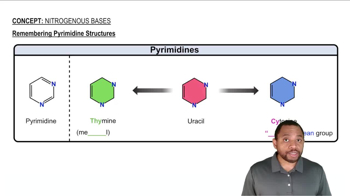Here are the essential concepts you must grasp in order to answer the question correctly.
Biomolecules
Biomolecules are organic molecules that are essential for life, including carbohydrates, proteins, lipids, and nucleic acids. Each type of biomolecule has distinct functions and structures, and they are composed of various elements, including carbon, hydrogen, oxygen, nitrogen, and phosphorus. Understanding the classification and roles of these biomolecules is crucial for identifying their components, such as the presence of nitrogen.
Recommended video:
Intro to Lipids Concept 2
Nitrogen in Biomolecules
Nitrogen is a key element found in several biomolecules, particularly in amino acids, nucleotides, and certain hormones. In proteins, nitrogen is a fundamental part of the amino group (-NH2) in amino acids, which are the building blocks of proteins. Additionally, nitrogen is present in nucleic acids (DNA and RNA) as part of the nitrogenous bases, making it essential for genetic information and protein synthesis.
Recommended video:
Nitrogenous Bases Concept 2
Identification of Biomolecules
Identifying biomolecules that contain nitrogen involves analyzing their chemical structure and composition. For example, proteins like collagen and hormones like epinephrine contain nitrogen due to their amino acid composition. In contrast, biomolecules such as glycogen and stearic acid do not contain nitrogen, as they are primarily composed of carbon, hydrogen, and oxygen. Understanding these distinctions is vital for answering questions about the presence of nitrogen in various biomolecules.
Recommended video:
Intro to Lipids Concept 2
 Verified step by step guidance
Verified step by step guidance


